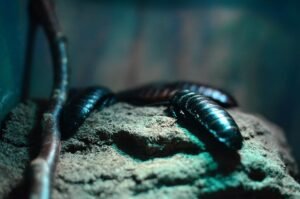Do Cockroaches Have Wings? Unfortunately, the short answer is yes, cockroaches indeed have wings that can help them in some way or the other.
Cockroaches have developed an infamous reputation as unwelcome houseguests that seem to survive even the toughest environments. They squeeze into tight spaces in kitchen cabinets, evade stomping feet, and attempt to exterminate them and find their way back no matter how many times you try to kick them out.
But while we spend so much time cursing these pests, many don’t realize that cockroaches actually have wings. That’s right—those creepy crawlers scuttling across your floor late at night can take to the air too.
So do cockroaches have wings? The answer is yes. Understanding their wings and flight capacity helps explain how roaches always manage to return after we thought they were long gone.
Why do Cockroaches Have Wings?
Cockroaches belong to the insect order Blattodea, comprising over 4,500 species, all of which possess wings. Their wings serve several important functions related to survival, reproduction, and spreading their populations far and wide.
1. Mating
Male cockroaches rely on their wings to take to the air and seek out females when mating. The flying males can detect pheromones released by females and track them to their location. This courtship ritual via wings allows cockroaches to find reproductive partners and propagate the species.
In some cockroach species, wings also come into play for male competition. Competing males will use their wings to swiftly reach sexually mature females to mate first. The males that can fly fastest and furthest have an advantage in passing on their genes.
So while cockroach wings may seem unimportant for day-to-day scavenging, they play a vital role in a roach’s reproductive success.
2. Fleeing Threats
When cockroaches detect danger like an approaching human foot or hungry predator, their first instinct is to flee. Their wings allow them to take off quickly and escape threats.
Cockroaches can’t cover huge distances with sustained flight. But they can flap or glide far enough using their wings to dart away into a hidden shelter or crevice. This offers a survival edge when facing attacks from enemies.
Baby cockroaches (nymphs) also have wing pads starting in their very first stage of development. So even juvenile roaches have the wing equipment to take flight when facing attacks.
3. Reaching New Environments
While not the strongest fliers, cockroaches rely on their wings to disperse their populations to infest new zones. Short aerial journeys powered by their wings let them reach and migrate to locations with better food sources and hiding spots.
This explains why eliminating a cockroach infestation in one apartment often leads to neighbors reporting roach sightings next door soon after. The wings provide just enough airtime for cockroaches to spread to nearby dwellings in search of better real estate options.
Outdoors, and cockroaches use wings to move between yards, sewers, trees, and other urban habitats. So wings serve roaches well for invading greener pastures both indoors and out in both rural and metropolitan areas.
4. Species Variations
Over 4,500 species of cockroaches exist, and they don’t all possess the same type of wings. Variations in wing size, shape, and function occur across different roach species.
The large wings on cockroaches like smokybrown cockroaches and American cockroaches give them stronger flight power. They can really take off and stay airborne for more extended glides. This comes in handy for fleeing leaping predators like frogs and birds over longer distances.
Smaller roach species like German cockroaches have much tinier wings relative to their body size. This limits them to shorter hops via flight. So they stick to running to escape threats and restrict aerial journeys to quick hops between locations.
Other odd roaches like cave cockroaches or wingless cockroaches have no wings at all or very underdeveloped non-functional wings. Not needing to fly in their predominantly grounded existence, evolutionary forces led to the loss of wings in these weird roaches.
5. Surviving Attacks
Cockroaches live life as prey, constantly facing attacks from predators aiming to eat them. Whether it’s a mouse lunging to bite them or a human wielding a rolled newspaper or bug spray, roaches rely on their wings to flee these offensive strikes.
Taking quick flight by flapping their wings gives roaches an advantage against these predators. An airborne cockroach is tougher to catch or strike as it parachutes away to safety.
This key survival tactic explains why pounds of insecticides rarely eliminate full infestations inside homes. The winged roaches escape the spraying to live and reproduce another day.
6. Infesting Structures
Cockroaches depend on their wings to initially migrate into indoor habitats and buildings. While tiny cracks or gaps afford them some entry access, wings give roaches the lift to reach higher points of entry like open windows, vents, pipes, balconies, and roof edges.
Related post Flying cockroach: 9 Facts About flying cockroaches
Once inside, they rarely need a sustained flight to get around. But brief glides supported by their wings do help roaches spread to infest all corners of indoor spaces. Kitchens, basements, attics, and bathrooms all serve as hot destination spots to start breeding colonies.
So while cockroaches don’t fly circles around your ceiling, their wings facilitate getting inside and the initial tour of their new home after arrival. This makes controlling an infestation harder, as roaches use wings to access spots we can’t easily reach.
Cockroach Wing Anatomy
Cockroaches belong to the class Insecta, which means they have the trademark insect body plan featuring three main parts – the head, thorax, and abdomen. Their wings attach to the middle thorax region, specifically a hardened plate area named the tegmen.
Two pairs of wings anchor to the tegmen, but only the top pair actively provides lift and mobility during flight. The lower set of wings instead acts as covers to protect the flight wings when at rest against the body.
The flight wings consist of a thickened front vein structure that supports thinner interconnecting tissue membranes. Rather than solid wings, the delicate membranes allow for folded collapsing against the body.
This presents less surface area to catch wind gusts when grounded, while the foldable flexibility affords an easy opening to catch air when taking off.
Cockroach wings connect to large powerful flight muscles inside the thorax that rapidly contract on demand to drive wing beats for lift. Additional layers of cuticle on the wings and branching vein patterns provide structural support without excess weight, keeping the wings lightweight enough for short airborne trips.
The hindwings also contain specialized hook structures that grab onto the forewings, creating temporary wing couples during flight for added aerodynamic efficiencies. Once landed, the wings then decouple and fold back into place flush against the body.
What does it mean when a cockroach has wings?
A cockroach with wings signals it has completed its lifecycle into a mature adult now capable of quicker evasion from dangers, traversing more distant terrain via flight to find food and shelter, locating reproductive mates more effectively, and spreading populations by migrating to infest new areas through its improved mobility and access to higher spaces afforded by having functional wings.

How many wings has a cockroach?
A cockroach has two pairs of wings, so four wings total. The top pair are the main flight wings, while the bottom pair serve as protective covers over the flight wings. When at rest, the flight wings fold backwards in a leaflike pattern and are shielded by the shielding underside pair.
During flight, small hooks on the hindwings grab onto the forewings to create temporary wing couples for added aerial efficiency. So while cockroaches have four wings, only the top set actively powers their short bursts of flight. The four wings provide both flight ability and protective coverage when grounded.
Why Are Their Wings Important?
While cockroaches can’t migrate thousands of miles relying solely on wing power like birds or insects like monarch butterflies can, their wings serve crucial functions in their fundamental biology and ecology.
Understanding cockroach wing anatomy and flight capacities provides insight into their uncanny survival abilities and reproduction strategies. It also explains how they easily invade and spread throughout human dwellings once access is obtained.
Blocking structural entry points that require wing-assisted reaches offers a key pest management tactic. Installing fine window screens, sealing open vents with wire mesh, and keeping doors shut deprive roaches of aerial access paths inside. This forces them to rely solely on ground entry through cracks – access points easier to treat with boric acid dust and gel baits on floors.
So while cockroach wings provide only short bursts of airtime, they confer key survival advantages central to the incredible cockroach success story over hundreds of millions of years. Their wings serve them well as both indoor pests and outdoors in natural settings.
Next time you spy a roach’s wings helping it glide away from threats, appreciate you’re witnessing the biological tools that help explain why cockroaches have prevailed as one of Earth’s most triumphant organisms. Their wings may annoy households worldwide, but they underpin key survival and reproductive strengths, permitting cockroaches to rule all habitats they infest near and far.



